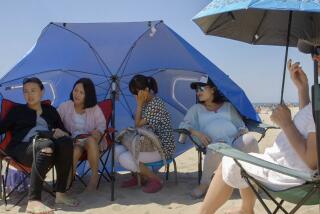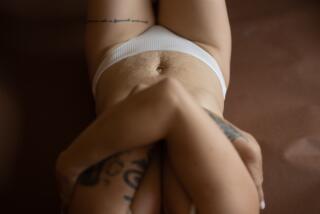How to Start the Family Album at Childbirth
- Share via
Photographing the birth of your child may result in the most rewarding pictures you’ll ever take. Cameras, it seems, have become second nature in most hospital delivery rooms.
As with most everything in photography, the more prepared you are, the more likely you are to get the pictures you want. For starters, don’t plan on any quick stops at your local all-night convenience store for film at 4 a.m. When the contractions come, your mind will be more focused on getting to the hospital than a quick stop for film and a lottery ticket.
The camera should be loaded and an extra roll packed in the camera bag. Batteries must be charged ahead of time, and your camera gear should be packed and sitting next to the suitcase. Your checklist should include camera, lenses, flash, filters, film and extra batteries.
Don’t take it for granted that you will be able to take pictures in the delivery room. It’s important to check with your doctor and hospital at the beginning of the pregnancy to find out their policies on photography.
An advance trip to the hospital is helpful. Take a look at the delivery room to check the lighting, the size of the room and from what angle and distance you’ll be shooting.
Your angle should be a consideration. Remember, these photos will probably make the rounds among relatives and friends. It’s also important to edit the photos later so that people are seeing only what you want them to see.
Shooting the photos of the birthing process is different than viewing it as a spectator. You will be looking at it from a different perspective--through the camera. The ideal situation is to have a friend shoot the pictures, so that dad is free to help with the delivery.
Being the birthing coach, father and photographer all in one is pretty tough duty. And obviously, most of the emphasis should be on helping the mother give birth. There is plenty of time afterward to take photos.
Another important decision will be which film to select. Your first choice should be whether to use color or black-and-white film. This is personal choice. You should base your decision on how you plan to display the photos.
Black-and-white film is a great choice if you do your own darkroom work. A film such as Tri-X with its film speed (ASA or ISO) of 400 gives great flexibility. With black and white there are no problems with color balance, and if the room is darker that you expected, you can easily push the film to a rating of 800 or 1600.
For most, using 100-speed color negative (print) film and a flash (strobe) is best. This gives you plenty of depth of field and light. This also takes away any worries about the darkness of the room.
Bouncing the flash (if your strobe has the option) off the ceiling can eliminate the harsh light from the flash. Check the color of the surface from which you will bounce the light. If it’s white, there is no problem. Other colors create a problem because the flash will pick up the color of the ceiling.
Using color print film with speeds of 400 or 1600 and shooting with available light is an alternative, particularly if you are worried about the distraction of the flash. Color balance will be a problem. Most delivery rooms are not balanced for daylight film. The colors in your prints may be off unless the photo lab makes the proper correction when they make the prints.
Color slide film gives the least flexibility. The use of flash or filters is a must in order to have the proper color balance.
Stay away from the quickie photo labs for this film. Make sure you take your film to a reputable and experienced custom photo lab. Ask a photographer you trust for a recommendation.
There’s a strong possibility that your baby may be spending some time in the hospital nursery. Getting good photos in that location may require some extra thought. Shooting photos through the glass into the nursery shouldn’t be a problem. Just move the lens as close to the window as possible. This will be a good time to try an available-light shot. A short telephoto lens is advisable. Hold still when you press the shutter release.
Your photos may turn out a little green unless you use flash because the color film you will be using is balanced for daylight. Most hospital nurseries use fluorescent light.
If you’re using an automatic focus camera, it may be fooled shooting through the glass, but it’s worth experimenting with the shot. Shooting a flash through the glass is another tricky proposition. It will solve the color balance problem, but reflections in the glass are very unpredictable. Try a couple of shots with the flash and then without it.
Many hospitals, such as the Los Alamitos Medical Center, have Alternative Birth Centers and encourage photography of the birth.
According to Marjorie Pyle, parent education and alternative birthing coordinator at the medical center, the important photos to capture are the couple in the hospital before labor, working together during labor, the crown of the baby’s head coming out, mom’s look of joy when the baby is born and brought up to her breast, a shot of the parents kissing and hugging after the birth, weighing and measuring, dad looking at the baby with his large hands touching the baby’s miniature hands and baby’s first bath.
“Keeping yourself at a good pace is very important,” Pyle said. “The birth may take many hours, and it’s easy to run out of film.” She has seen many couples come to the hospital with new cameras for the occasion. She recommends familiarizing yourself with the camera before the birth.
Stay away from Polaroid instant photography as your primary pictures. The color will fade over the long haul, and making enlargements is a problem. Stick with a quality 35-millimeter camera.



